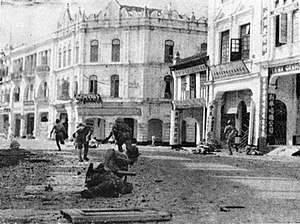Battle of Kuala Lumpur
The Battle of Kuala Lumpur was a battle between Japanese invasion forces and the British forces in Kuala Lumpur, then capital of the-Federated Malay States, a British protectorate.
| Battle of Kuala Lumpur | |||||||
|---|---|---|---|---|---|---|---|
| Part of Pacific War, World War II | |||||||
 Japanese troops advancing through Kuala Lumpur. | |||||||
| |||||||
| Belligerents | |||||||
|
|
Twenty-Fifth Army: | ||||||
| Commanders and leaders | |||||||
|
Arthur Percival[1] Lewis Heath Henry Gordon Bennett Merton Beckwith-Smith |
Tomoyuki Yamashita Takuma Nishimura Takuro Matsui Renya Mutaguchi | ||||||
| Strength | |||||||
| Unknown | Unknown | ||||||
| Casualties and losses | |||||||
| Unknown | Unknown | ||||||
Background
Japanese naval aircraft launched the first air raid over Kuala Lumpur on 21 and 22 December 1941. British anti-aircraft guns and RAF aircraft intercepted the attack and shot down one Japanese aircraft and damaged another.[2][3] More raids followed on the 25th and 27th. The last bombing was on 10 January 1942, after Port Swettenham fell.
By 7 January, the northern part of Malaya, including Perlis, Kedah, Kelantan, Terengganu and the Straits Settlement of Penang had fallen into Japanese hands.
After the Battle of Slim River, the Japanese troops' next military objective was Kuala Lumpur. Being the capital of the Federated Malay States it was of utmost importance to the Japanese. Kuala Lumpur by then was also the capital of the State of Selangor. The city was also home to RAF Kuala Lumpur.
Prelude
On 7 January, it was decided to abandon Selangor and Negeri Sembilan to the Japanese, and British forces began a quick retreat to Johor then to Singapore. The city, now abandoned, quickly descended into a state of anarchy and chaos. Looting was widespread; the Robinsons and Whiteaway and Laidlaw department stores at Java Street were sacked by panicked KLites. Cinemas such as Cathay and Odeon at Batu Road were closed, and the Malay Mail published its last pre-war issue. The FMS administration is no longer in place.[4]
As the British retreated, they continued the scorched earth policy they had used in Perak - tin mines, rubber plantations and munitions were simply torched. Fires continued to burn for days even after the Japanese took over Kuala Lumpur.
Japanese entry
On 10 January the Japanese reached Serendah, about 26 km from Kuala Lumpur.
The following day the Japanese entered Kuala Lumpur without much resistance, besides small skirmishes. The British troops had left the city. The Japanese troops quickly took control of government and institutional buildings, such as the Sultan Abdul Samad Building, the railway station and the Pudu Jail.
After the battle, the Japanese used Pudu Jail as a POW detention centre. Many Allied POWs were tortured to death.
Aftermath
Kuala Lumpur, with the rest of the peninsula, remained under Japanese occupation until September 1945, when the Japanese home islands surrendered unconditionally after the atomic bombings of Hiroshima and Nagasaki by American forces in August 1945. The British Military Administration took over thereafter.
Little is known about the battle, since it did not bear much significance when compared to greater battles in British Malaya such as the Battle of Singapore. This piece of history was slowly forgotten by people, as Kuala Lumpur advances to being a global metropolis.
See also
References
- L, Klemen (1999–2000). "Lieutenant-General Arthur Ernest Percival". Forgotten Campaign: The Dutch East Indies Campaign 1941-1942. Archived from the original on 24 September 2011.
- "22 Dec 1941 - KUALA LUMPUR ATTACKED". Trove. Retrieved 28 June 2013.
- "Artist's impression of aerial battle over KL on 22 Dec 1941". Retrieved 28 June 2013.
- Barber, Andrew (2012). Kuala Lumpur at War, 1939-1945. Karamoja Press. ISBN 9789834337247.